



“Festival of Ideas For A New City” organized by the New Museum, The Architectural League, The Bowery Poetry Club, C-Lab, Columbia University Center for Architecture, Cooper Union, The Drawing Center, NYU Wagner, PARC Foundation, Storefront for Art and Architecture, and the Swiss Institute blossomed like spring in New York City from May 4 – 8th, setting out to “harness the power of the creative community to imagine the future city and explore the ideas destined to shape it.”
Keynotes addressing the issues were architect Rem Koolhaas, virtual reality inventor Jaron Lanier, and former President of the National University of Columbia, and former Mayor of Bogota, Antanas Mockus. A StreetFest set up along the Bowery with over 100 local grassroots organizations and small businesses “presenting model practices and products in a unique environment.” Over 100 projects, events, performances and walking tours expanded on the Festival’s themes.
Rem Koolhaas with OMA and The New Museum showcased CRONOCAOS, an exhibit examining the growing “empire” of preservation and destruction and the consequences of how we build, rebuild and remember. What is the role of preservation on the art world? As larger and larger spaces are repurposed for art from industrial spaces they focus on the “apocalyptic sublime,” mimicking Hollywood and B movies. Oddly enough Koolhaas noted, this increase in preservation closely parallels the rise of Wall Street and tourism.

There were panels on “The Heterogeneous City,” “The Networked City,” “The Reconfigured City,” and “The Sustainable City.” At night curator Anna Muessig’s Flash:Light Nuit Blanche event included murals along the Bowery, art projections on Nolita and Lower East Side buildings, and music and performances including projects on the facade of the New Museum and St. Patrick’s Old Cathedral in Little Italy. There was also a 3D video installation Civilization reinterpreting Dante’s Diving comedy.
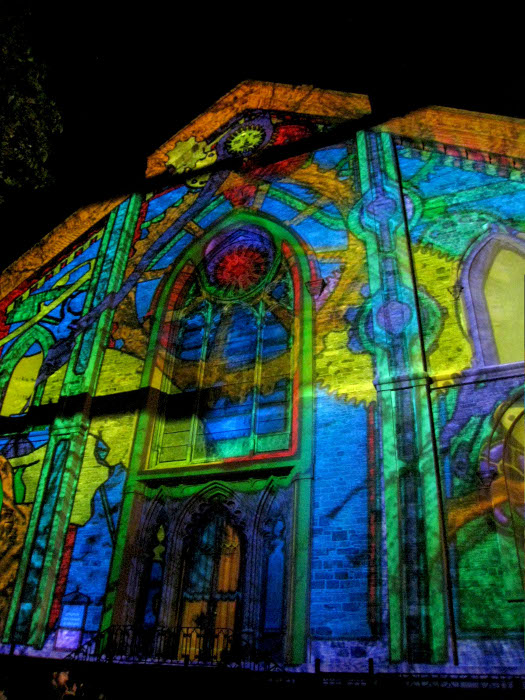

Jaron Lanier’s Keynote address on “The Networked City” at the Great Hall at Cooper Union reiterated many of the themes in his new book, “You Are Not A Gadget.” Not one to follow any set path, Lanier began his talk by playing a Laoitian “Ban Lao” (Ban Bang Sai Kai) bamboo wood pipe. He declared the simple reed flute was one of the first holders of digital information, even older than the abacus, because each reed object and note is turned on and off just like a series of digital 0’s and 1’s. The Ban Lao, traded across the Silk Route was noticed by the Greeks and Romans, and influenced the development of the pipe organ. The pipe organ was automated and turned into a player piano, a programmable loom, and finally became the origins of Charles Babbage’s computer.
Computers have gotten better Lanier explained, processing more and more bits, but humans still have more precise acuity at the level of quantum physics. They can respond to just one photon. He then veered off topic discussing the first computer scientist Alan Turing who used computers to crack codes during World War II. Persecuted for being gay, he was injected by authorities with female hormones which gave him breasts and made him suicidal. Just like Snow White, he killed himself by eating a poisoned apple.
He then veered back on track saying using computers as metaphors to the human condition is an irrelevant, outdated metaphor. The brain is not a CPU, and eyes and ears are not USBs. A better metaphor is thinking of the head as a spy submarine performing spy missions. You are constantly moving your head seeking out data, not passively seeing it. Your visual system is sensitive to minute differences. A musical instrument is an additional instrument to the sensory motor loop that makes perception possible. Can we build digital tools that are as sensitive as we are? This, he noted, was one of the key questions now facing computer scientists.
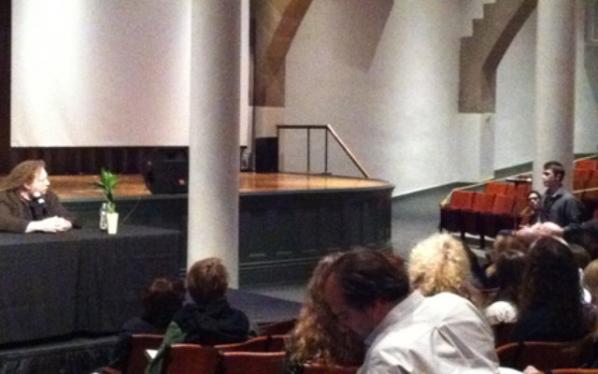
New technologies are usually developed to become weapons. But many important inventions were first developed for music. Musical bows existed before arrows, and guns developed from the casting of metal bells. Even Hewlett Packard’s first object was a musical synthesizer. Music is a driver with innovation taking place around making sounds.
In order to make his lecture relevant to the “Networked City” theme of the festival, Lanier discussed his favourite thing about New York City, that the same sense of acuity as applied to musical instruments also applies to personal interactions. More diversity means you have more chance of connecting with someone who will change your life. The fates of people in New York are guided by their activities. Its important that the fates concern an extra world of human to human contact.
In such a huge network context people are sensitive to subtle motions in each other, and can identify subconscious communication we don’t really know about. Contrast that to sound networking, where digital music does not give you the subtle minute accuracy of acoustic sound. People who only communicate virtually are spinning their wheels in place. When we connect to each other through digital representations we lose some form of expression.
Lanier proselytized for the necessity of the “head and the heart”, insisted technology needs to bring better jobs to society than the ones they are destroying. The basic social contract he said was turned back 11 years ago when advertising became the new way to get information. Sergey Brin, the co-founder of Google was the one who started it. Because digital technology is cheaper, cheaper just gives this stuff away for advertising. But, when you take the products of people’s hearts and minds, such as their music and literature, and give them away for free this becomes a problem. When you put effort into a promotion on line you get the illusion of benefits, but you actually lose relative advantage. This is because the true customers of a social networking site like Facebook is not you, you are actually the product of Facebook. You are sold and the customer pays to influence events. This is the difference between overt and covert information with Lanier stating, “The official business of computation is advertising.” At some point though, there is nothing to advertise. If cars can drive themselves, what happens to truck drivers? Or if 3D machines make fabrications they make manufacturing obsolete.
The Japanese are creating elder care robots. We are making ourselves unemployed. The fashion of making everything free leads us down a path from a city of dreams to a cry of despair. We have to figure out a way to change our relationship to information technology, instead of chasing after users and followers and making more money. Ending his lecture he declared, “We must humanize digital architecture – We must see beyond fads.” And then he played a little ditty on dual Gypsy flutes.
Furtherfield is pleased to present the UK Book launch of STATION ROSE: 20 Digital Years Plus, published by Verlag für Moderne Kunst Nürnberg.
DR. Richard Barbrook will give a short introduction to the evening.
The Digital Art of Station Rose started in Vienna in 1988, at a time when the Web still was far beyond mainstream, when Mondo 2000 never had heard about the music genre “Techno”, when future net-art-critics still mostly were university students, and when the Iron Curtain was surrounding Austria´s east, south east and north border.
“Station Rose had every right to claim ‘cyberspace is our land.’ They were there very early, they raised their antennas and put down deep roots, and they never left.” – Bruce Sterling, 2010
Station Rose, pioneers of digital culture, have produced an artist’s book which delivers a current description of the situation of media art from 1988, when the studio was founded, until 2010. Station Rose (Elisa Rose and Gary Danner) are considered to be innovators and visionaries in the field of audiovisual art, electronic music, net art and audiovisual live performance. The book features audio-visual works, performances, installations and Web 2.0 activities and linkings. Part of the book is dedicated to the media sculpture LoginCabin exhibited for three months in 2009 in the MAK in Vienna.
The latest art of Station Rose refracts the logistics and glitches of the Internet through the deceptively low-fi aesthetic of contemporary art’s installations and performances. “Twenty Digital Years Plus” shows how this fits into their history of using the viruses of visual, verbal and computer language to find insightful ways of conceptualising digital culture.
RSVP – Please contact Ale Scapin
http://www.stationrose.com/STR-Books/20DYplus-book.html
http://www.furtherfield.org/contact
Station Rose 20 Digital Years plus. 1988–2010 –>
paperbook with flaps 16,5 x 22 cm
192 pages., german/engl.
Euro 40,00/sFr 64,00
ISBN 978-3-86984-111-3
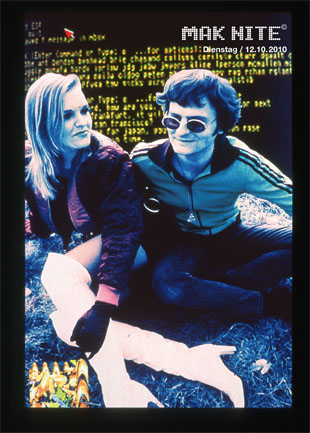
Peter Noever (preface), Howard Rheingold, Bruce Sterling, Gabriele Horn, Vitus H.Weh, Didi Neidhart, Peter Weibel, Dr.Hans Diebner, Christoph Tannert, David Hudson, Terence McKenna, Elisabeth Zimmermann, Doug Millison, Dr.Timothy Leary, Elisa Rose, STR, u. a.
Österreichisches Kulturforum Berlin, Stadt Frankfurt am Main – Dezernat für Kultur und Wissenschaft, BMUKK Wien, Hessisches Ministerium für Wissenschaft und Kunst, Kultur Land Oberösterreich.
Distributed in the United Kingdom
Cornerhouse Publications
70 Oxford Street, Manchester M1 5 NH, UK
phone +44-161-200 15 04, fax +44-161-200 15 04
Distributed outside Europe
D.A.P. Distributed Art Publishers, Inc.
155 Sixth Avenue, 2nd Floor, New York, NY 10013, USA
phone +1-212-627 19 99, fax +1-212-627 94 84
Featured image: An interview with Chris Dooks, a ‘Polymath’ exploring various creative avenues, making his art using different media.
One of the many interesting and rewarding elements of being deeply involved in what, I’ll loosely term as ‘media arts’ practice, is the breadth of imaginative people you meet along the way. We first met Chris Dooks in 2005-6, when he worked with us on a project by Furtherfield called 5+5=5. We commissioned 5 short movies about 5 UK-based networked art projects exploring critical approaches to social engagement. These pieces offered alternative interfaces to the artworks and the every-day artistic practices of their producers. Including the motivations and social contexts of artists and artists’ groups working with DIY approaches to digital technology and its culture, where medium and distribution channels merge. Chris produced a film-work for the project called Polyfaith. A Psycho-Geographical Web Project introducing the beliefs and philosophies of his (invented) friend Erica Tetralix.
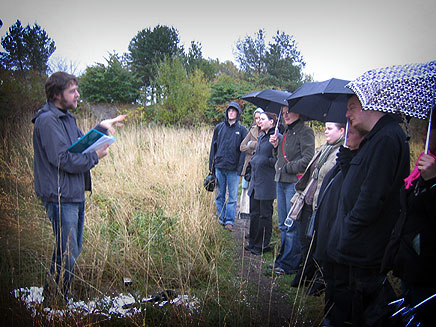
“My friend Erica Tetralix died. She gave me the task of fulfilling her dream which was that people would enjoy the parts of Edinburgh that were so dear to her in her life. She also loved tourists and sympathised with people on a budget, so she devised, with my posthumous help, this free way to enjoy the city. It’s a beautiful gift for both transients and residents. It’s popular with backpackers, parents and children, cultural groups and well, basically anyone.”
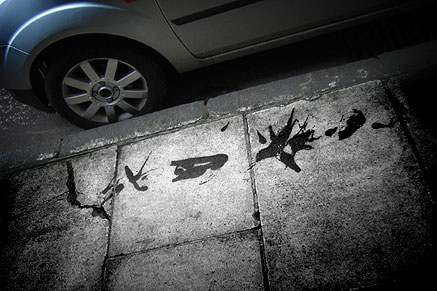
Later on we discovered that the name Erica Tetralix, is actually a name of a plant. Often called a cross-leaved heath, a species of heather found in Atlantic areas of Europe, from southern Portugal to central Norway, as well as a number of boggy regions further from the coast in Central Europe.
To view Polyfaith visit link below:
http://furtherfield.org/5+5=5/polyfaith.mov
The value of an interview is that it can serve as a useful documentation, a process allowing a kind of unfolding of time, All layed out in front of you. The reader can experience not necessarily a retrospective, but a dynamic and creative life and a personal history openly shared, on their own terms.
This interview reveals various levels and approaches by Chris Dooks. An inquistive and playful mind is at work here, engaged in exploring across different forms of personal agency, as well as redefining his practice in relation to the world he exists in, and the people he comes across in connection to various projects. His art is not a singular activity. Meaning, he does not rest in one particular art genre or movement. Instead, we are asked to acknowledge a personal enquiry formed from different engagements and choice of mediums, which happen to meet his creative intentions and questions at the time. We are all relational beings and Chris Dooks is a clear example of how this can work in an artistic context.
The Interview:
Marc Garrett: Many out there will already know you as a professional film maker, directing arts-based TV documentaries such as The South Bank Show in your twenties. Since then, you have developed other skills involving design, composing and making music, audio visual installations, explorative psychogeographical projects, as well as continuing making films, and you’ve even got a record deal. You have as far as I can gather four different music projects curently on the go, your electronica group BovineLife, an architecture music project known as As Ruby’s Comet, Feible for laptronica and also the Audiostreet project featured at The Leith Festival.
Chris Dooks: It’s amazing how many people still know me from Bovine Life which was a moniker I used for an internet audio project way before broadband in 1999. It’s the tenth anniversary of my bip-hop album SOCIAL ELECTRICS and I would like to make all my albums available for free for furtherfield readers. Don’t let itunes rob me of any money! The transition to musician was down in part to the South Bank Show when working with Scanner. I was really frustrated at making work about musicians. And the technology was making it easier for folks like me without a classical training. Here are three for you for free – check links below for free tunes at the bottom of the interview.
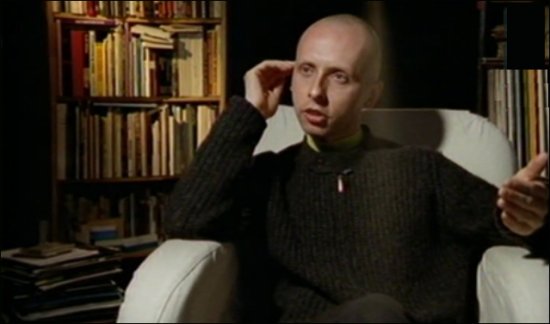
South Bank Show UK television documentary directed by Chris Dooks, featuring Robin Rimbaud speaking about his practice and ideas. 1997. Click here to watch video.
MG: In The Glasgow Herald, in Scotland a journalist called you a Polymath. Even though you were delighted to receive such a compliment in the local press, you decided to re-edit the term, reclaim it so to make it less seemingly mathmatical. Prefering Polymash because it sounds “friendlier, resourceful and potentially charming.” Sticking with this notion of you being a Polymath or rather a Polymash. Your diverse approach in creating art works in a non-singular approach, is a core element of your practice. I was wondering whether this is a deliberate decision or a natural and overall state of being?
CD: It’s weird though, I learned more in my background as a wedding videographer aged 14-19 (35 weddings at weekends!!!) than on any other course. Doing weddings gives you various skills as a digital artist. Fuck a film degree! As a wedding videographer, you need to be able to mike the vows in difficult audio environments (i.e. reverby spaces), film it about fifty feet away, liaise with highly emotional temperaments, be like a war photographer – it’s only gonna happen once, miss it at your peril – and stay sober. Not to mention edit it at a time when non-linear editing was non-existent, (I remember the heady days of “crash editing” between two panasonic VHS machines) white balancing everything on manual heavy equipment and creating all the graphic design and labelling of tapes. I was like a teenage record label!
So in 2009 when I made www.studio1824.com – making a record (netlabel) for an icehouse in Sutherland (remote Scottish Highlands) I got a kind of deja vu experience. Only with an education and life experience in the mix now.
When I was 8 years old, I had two epiphanies. One was that death is really gonna happen, and two, that cinema is wonderful, emotional and that it offers us a naive form of immortality. Cinema was the only artform that even at that age, I felt could make me feel…spiritual, for want of a better term. I became quite religious.
I was obsessed with super 8 cameras and video. And now I am trying to get all my pre-teen works tracked down! But even at this stage there was always a healthy distraction in other areas. I wouldn’t get involved with narrative and this has never been my strong point, even though I was reasonably good with words. My uncle played a lot of classical music and my dad took me all over the UK in his lorry, and at this time I won a scholarship to play the cello at school with the posh kids, being the other three. (It was a working class music “initiative”) But alas, I didn’t realise how lucky this was for me. So I went back to making videos, this “poly” approach was probably set quite early. I remember doing a kind of pre-Blair Witch thing when I was 14 and I would get sidetracked into filming the shapes of the leaves and the sound of the wind. Then I realised that the material didn’t make sense in the conventional sense. So I became an aesthete of kinds at an early age. And in every way, from Granny’s trifles and an early lust for Kate Bush, I was concerned with the sensual world. But until 22 I was monogamous to film projects and would work as a corporate director in the art school holidays to fund my college life, with the odd wedding video thrown in. By the time I did my film degree at Edinburgh College of Art, I was much more interested in people like video artists Bill Viola, Gary Hill and Daniel Reeves – (I met all three) via the “team-building” world of film shoots. Bill Viola’s THE PASSING changed my life.
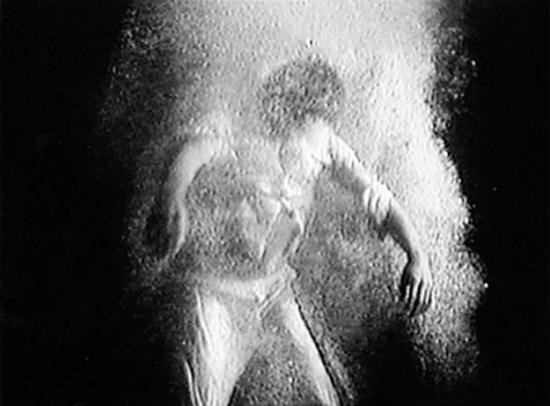
The Passing, 1991. In memory of Wynne Lee Viola. Videotape, black-and-white, mono sound; 54 minutes.
Pre-degree, in those days (1989-91) you had to REALLY know your kit and be a good all rounder. I trained on huge Umatic machines and did a BTEC before a degree. I was from a part of a culture where there was no film degree, and I was a couple of years behind my peers. But by the time I hit ECA, I could mix radio programmes, edit timecode, black and white balance studio cameras and location kit and I spent most of the time buggering off to the hills to film Scottish waterfalls. I might have been techinically proficient and this was behind the poly approach to an extent, but I had bugger all conceptual skills. These have only really solidified in my thirties…
MG: Lets talk about the Surreal Steyning psychogeographic audio tour, part of the The Steyning Festival in 2009. On the web page for the project is written “This tour is simply a different way to skin the proverbial cat. In this case, the cat is Steyning. In fact, if you think of Steyning as a cat, you are already a psychogeographer. Well done. You’ve engaged your psyche with geography. You’ve mapped the town conceptually. The High Street becomes the cat’s spine with the head chasing Mouse Lane. Now you are in the same company as such artist groups as the Situationists, the Dadaist Movement and other high fallutin ripples in art tourism, and even The Ramblers.” Did those who took part manage to understand and appreciate where you were coming from? Also, how did it work?
CD: There was a tiny degree of spin with the site’s headline Traditional English Town Embraces Conceptual Art Walk but by and large folk did embrace it and it would have been patronising not to drop a little sand in the vaseline, not to deliberately challenge, because the Steyning Festival, was, I felt, in danger of being a little like a tasteful village fete. A good fete I might point out, so this year, there was something brave about them putting a conceptual artist at the heart of a residency in the village. English villages like Steyning were not and are not, all tasteful. Whenever I encounter these tasteful expectations in the arts, I think of that Stereolab song, Motoroller Scalatron with it’s chorus “What’s society built on? It’s built on blood. (some say the lyric is “bluff” not blood but either way it works)” So I saw my role not as a socialist historian, because I wouldn’t have a clue, but as someone who encourages an enquiry per se into unusual histories, paganism, aesthetics and philosophies of very local travel. I mean, I don’t think there’s anything angry or unloving in the tours. In fact, I try to make them about folk being nicer to each other. These activities have a small socialist agenda but as a performer, I am not exactly Stelarc, slashing my wrists in the street. I’m not about shock! However, this tour had a couple of “jaw droppers” (See The Steyning Star on the tour). The main outrages came from people who wanted a straight history tour and were not given one, depsite my first words on the tour saying “this is NOT a history tour!”
Example taken from section 4 of the The Steyning Star on the tour:
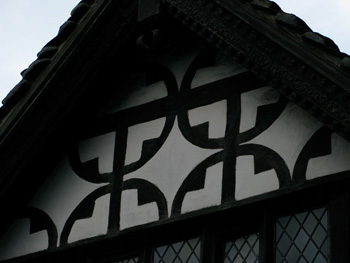
“This is Brotherhood Hall, built in the fifteenth century and now part of Steyning Grammar School. Look closely at the symbols which adorn the gables. They may look like simple decoration to us, but these markings are rather unusual. They have been the subject of no fewer than three PhDs, and for a century the world’s leading symbologists have engaged in hot debate over how to read the meaning of them. One of the most important questions is what shape we are dealing with. While some people see predominantly circles, others see squares and diamonds, rather like those tiles that everyone had in their bathrooms in the 1970s.”
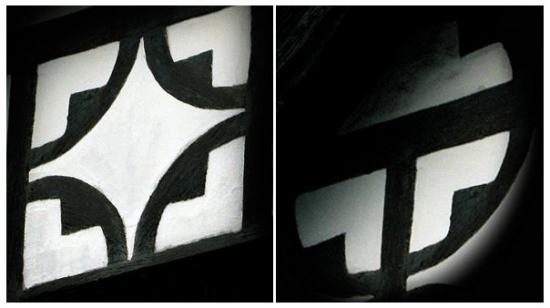
“Was this a pop premonition? For some time it seemed so, and this remains a strong theory. But in the mid 90s the school took part in a German exchange programme, and visiting German students proposed yet another alternative. When they looked at the patterns on the gables they saw a cross drawn within the circles, or a gammadia, to be more precise. A gammadia is a cross voided through, or a cross formed with four of the Greek letter Gamma. It looks a bit like an ‘L’ to us. The swastika is the most famous example of a gammadion. The German students believed that this was not a pop premonition at all, but a foretelling of the success of German heavy metal band Gamma Ray. This theory also gained popularity among members of the school’s very active astronomy club.”
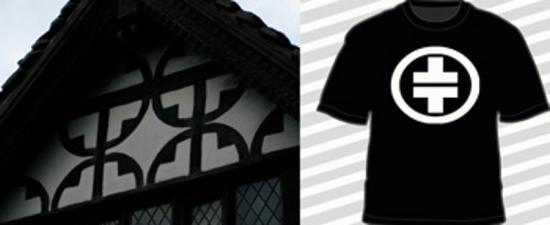
The festival had hired a PR person to market aspects of the festival and commission an artist, and so I was brought there with a little Arts Council of England fund, so felt obliged to make work with the tools I’ve been developing – or my “brand.”
Nothing was watered down simply because it was a village (it’s actually a town but it feels like a village) because it would have meant compromising the ideals or enquiry, of looking deeply and into the areas of my interests of paradolia (faces in chaos) and simulacra formations (things that appear to be other things).
Most of them got it! I mean, it was nearly two hours long and they stayed till the end, although it did split the audience, but not badly. 2-3 out of 20, left. We had to do it again the next day due to popular demand! The ones who stayed had smiles on their faces by and large, which made me very happy. The weird thing was, not once had it been stated that it was a “straight history tour”, and it should have been obvious within the first thirty seconds that I make some of the stories and hypotheses so outrageous that surely this is tongue in cheek? However, I had written some slightly anti daily mail sentiment in it and two or three people angrily walked out of the tour. I got that wrong. It’s a Tory (conservative) heartland, and I don’t think you can be an artist and right-wing, you are just too aware of the world, but I should have considered this aspect more.. My landlady was one of the people present in the audience and she walked out, that upset me a wee bit.
But there’s something about my personality that makes people trust me in my tours, folk are quite sweet and gentle perhaps. The message behind the tours is one of re-imagining everything you hold to be true. The motivation behind these tours is to see travel as something that can be done anywhere. People go to the other side of the world to enrich their lives, many don’t even journey over to the other side of the street, or drive through a different part of town! I find that hilarious. So for me, psychogeography is about the chicken crossing the road..
If we can’t even do that, what hope is there for atheists like me (who find Buddhist philosophy and its practice the only religion without the conceit of the other big hitters) who are forced to approach the world from multiple angles, because we can’t accept the idea of monotheism and monotheistic thinking. This single mindedness of approach, when challenged (not just in religious people, but people stuck in their ways) is bound to create a bit of friction even on a playful level like in Steyning.
I became invloved in Surreal Steyning based on another project, in Brighton, where I made several songs about a building on Brighton sea front. This was a song cycle, based on a very specific bit of geography.
There is this idea that psychogeography is only urban – but I prefer to bring this intense work to the home counties! After all, the whole point of being an artist is to see through the privets, the darkness of the forests. So while I was in Steyning I was reading about Alistair Crowley and witchcraft and when Steyning used to be a port – it’s now land, ten miles inland! In the middle ages everything was different. I think a lot about how many contemporary English folk in these wee villages don’t realise their own foundations. I found Steyning a really charged place and not just a twee place to get (admittedly excellent) cream teas and real ale (a bit flat for my northern British palette).
This was, without a doubt though, the most successful public psychogeography tour I had done, even more than Polyfaith. There have only really been three tours – Polyfaith, Select Avocados and Surreal Steyning. And Surreal Steyning learned from the other two – so I had my schtick by then. I think it’s the best executed one so far. Let me be clear, I care about the audience. I adapted to their demographic, their language and their refinery in this tour, but I really care about people, but what I hate is bigotry and there was a little bit of friction about some of the left-wing ideas in the work and some of my own goals. But they needen’t be upset by a Middle East reading of a thatched cottage, the similarities of Tudor graphics and the 1990s version of the Take That logo, and the roof of some flats that might look like an arrow.
MG: This critical approach of consciously making room within yourself to understand or at least appreciate the sensibilities of others, surely it must be a difficult task to accomplish? What I find fascinating about your engagement with the public is the measure of respect for them, mixed with a healthy level of detournement.
Thanks! I actually think it’s a big complement to have the public stay on a tour for up to two hours, or buy one of my records. So I’ve really tried to attack attention-deficit tendencies whenever possible. It’s also my grammar. I don’t really do critical theory, although to apply for money you need to know where your bit of culture fits in with others. I really dig a good bit of popular culture. I think the best stories in our culture in the UK can all be seen on Jimmy McGovan’s The Street. He is a master of audience respect. Also, I feel confused by a lot of art, so I like to call a spade a spade, unless I am in a surreal mood and I’ll call it a Sad Ape (Sad Ape is an anagram of A Spade).
I had a slightly uncomfortable childhood and adolescence That “public” thing comes from Teesside. I also particularly like North of England humour – and actually I really like it when “clever shits” (to quote my Granny RIP) get usurped by that kind of spit-and-sawdust philosophy. There’s something survival-like and super-clever about grass roots humour because it comes out of neccessity. So I think my own personality is a bit of art school but with angry chips on both shoulders. It’s why working in Scotland is great, because the Scots hate bullshitters – especially the Nathan Barley set. I always found that very attractive. I remember seeing and being heavily inspired by Vic Reeves and Bob Mortimer’s first series and thinking, this is a dangerous combination! Northern swagger and charm! Dada! but with more academic kudos than might appear at first glance. And it was bloody funny! It was both alienating and accessible at the same time.
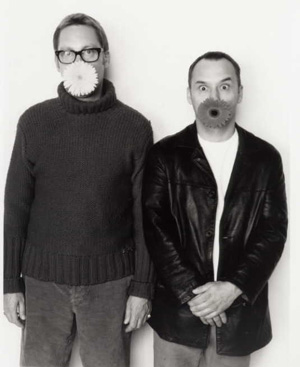
I grew up in Teesside and North Yorkshire and school never encouraged me really. I never had a bohemian upbringing, but I believed in the soul and went to Sunday School (my own choice – I was very religious for a kid). But I probably owe my interest in orchestral and “difficult” music to my uncle, and this was partly my first exposure to other worlds – I was particularly inspired by Bach’s Toccata and Fugue in D Minor. And I liked that piece because it had something I could relate to (the church organ), it felt something otherworldly – both the sustained drones and mechanical math-like, transcendental nature about it. And no words. I remember talking to my music teacher about it. She got all excited and presumed I could play it so she got me the sheet music to learn it. But I could never do it, I had no discipline. Anyway, that piece was amazing, spiritual to me. When you thought it couldn’t end, it changed scale and key and ascended to even more articulate heights, clever and gorgeously aesthetic at the same time.
I failed art. I grew up around lorry drivers, grandma’s trifle and Christmas at working men’s clubs. A lot of nice memories but I’ve always been looking for ways to sweeten the sour ones. And then, a huge affliction came. Around twelve, I started to have these really strong life changing shocks, like my psyche being ripped to shreds – just by thinking, enquiring, looking deeper. I would call them “dark epiphanies” later. They are still with me. Adulthood has not softened them. I’m always on the lookout for liberation! Like Russel Crowe in A Beautiful Mind he learns to live with his Demons and accept they are there! I’ll never get over these mortal messengers, but it’s what underpins all the puns and humour in the work. Tears of a Clown maybe? At the time, (aged 12-15) there were pennies dropping about mortality – real hopelessness of mortality. I’m still dealing with it. The problem is, because these visceral thoughts will never go away, I have started trying to make them my teachers. And all I want to do across all of my works is reduce anxiety – mainly my own – and look at multiple universes – and I think we forget that your street is part of the universe. That’s where the work begins, in your block, your local Lidl – these places should teach you as much about our ridiculous situation as anywhere else. It’s like that idea that “the environment” is outside somewhere, when really it’s in the most mundane places. The mundane is “supramundane” at the same time. It’s no wonder I became a Buddhist in my early thirties. I need to get back into it. I’m getting somewhere maybe.
MG: Perhaps, it is not just about re-inventing a selection of different mythologies, histories in relation to localities, whilst exploiting contemporary mediums; which includes elements of satire, a certain level of hyper-reality.
CD: I think it’s about a hatred of authority, not because we don’t need order, I think we do, but authority takes all the colour out of our history and culture. I watch X-factor, like Peter Kay (underrated surrealist like most comedians – despite the professional Northerner get up). I never liked punk and thought anarchy was really stupid! Civil disobedience maybe. I hate it when I see musos on the telly talking about punk, getting all nostalgic. Maybe the Clash. Maybe it’s the patronage of culture by high fallutin’ types I don’t like. Because patronage kills proper culture doesn’t it? And because of that, I never got passionate about history at school. It was a bit grey. So what do I do without the arsenal of the passionate historian? I make bits up and flirt with it. These projects mean I have to know bits of history now. And this bit is really telling – the bizarre thing about the hyper-reality aspects of my tours and other works – is that the bits I make up and flirt with – those bits are often scarily close to the truth. Also you say I’m really respectful to the public, but I like to push it a lot. In Edinburgh, on the Polyfaith tour, folk were swallowing my wildest tales about the city when they’d lived there all their lives! I came in under the radar I suppose. I like usurping the pompous stuff with a passion though, I really do, I feel it’s my duty!
MG: There seems to be a kind of niggling question in this work. I get a sense that this question does not only relate to asking those who take part, but also yourself. It touches upon something quite raw, authentic and complicated, and untouchable at the same time. I am not referring to the sublime here, it relates to all of our collective histories, on this earth. A Genealogical form of re-assembling, re-knowing and perhaps not knowing. Are you trying to make contact, or reconnect some how to a type of authenticity; if so, what does this look like in respect of your intentions?
CD: I want to find spiritual relief. That’s a terrible word – maybe the sublime is better. Fuck it, I want it back from the New-Agers. Even though I am a total Dawkins fan, and am partly liberated by looking deeply, I just want a bit of peace really. And the tours train me to think outside the box, that’s it. I suppose it’s like doing my own philosophy degree “in the field.” But there’s a bigger box I am being prepared for (see what I did there!). There’s not much relief. I am a highly charged person – some would say high maintenence! I’ve just seen the Andromeda galaxy from the back garden. I want more of that. This is a really hard life. I want to be less fat. I’m sick of having M.E. My wife is pregnant. Christ, I am going to be a father. Maybe that will help my afterlife woes. Men aren’t supposed to moan. I’m being genuine here though. I forgot to mention Derren Brown. I’d love to do a project with him. I am sorry these answers are not very articulate. It’s in the tours! Do them!? Seriously, do the tours.
MG: What qualities and values do you think or feel this form, process and working offers yourself, the world, art and culture on the whole?
CD: I look at my place in the digital arts as a priest being sent to a remote parish – so hopefully we’ll clean up here in Ayr, our new home! ha ha! A lack of funding might make that difficult but it hasn’t stopped me before. My current thoughts are… Paradolia and Simulacratic Forms as narrative agents for psychogeographical tours. The benefits of the sustained drone in music. “Dayglow” hues and man made fibres in landscape photography. High hills. The idea, place and value of the troubador in the present age and the potential of “singing the news” as a deterrent for media-saturation. My next project may be about folk-music and psychogeography, using local folk clubs to make popular songs based on themes by bloggers. Some of the things I think of, I sometimes see being made around the time. A bit of Zeitgeist, collective unconsciousness awareness maybe! I am also still digging around popular atheism and the atheistic roots of Buddhism. Folk-Art and the search for genuine Scottish culture as opposed to the much-touted facsimile. These are my daily concerns. A project that I should mention is Ayrtime. A series of eclectic cultural events presented in the heart of Ayr, Scotland. Gigs, Theatre, Literature, Astronomy & more – on this site you can find archives of the events with beautifully crafted podcasts!
My work offers me the stuff I was told at school really. No different to building or plumbing on one level. Just a sense of achievement and pride I suppose. Quite traditional aims. I remember a conversation with my dad in the last few years (we row a lot) in The Ship Inn in Marske. I asked him why he never wants to know about all these fantastic projects I’d done! And he said “Well that’s your work isn’t it? If you were a plumber we wouldn’t be sat here discussing U-bends” and at first, I felt slighted, I’m not a plumber I’m an ARTIST goddammit!! It made me think of The Cohen’s Barton Fink, human and pretentious character “The life of the mind, there’s no roadmap for that territory” but on reflection it’s quite good to be making this mad work in working class areas, to take my artist ego down a peg or two. Lord knows I need it sometimes because I have two fights generally – the first is the fight to get work funded and made and promoted and so on and it be stimulating work. The second is the fight with M.E. which I feel like I am totally on my own with a lot of the time. I get really unpleasant symptoms, often with no break for weeks on end. Sometimes I can only do 30 minutes of work in a day. Sometimes, even that is a pipe dream. I’ve had twelve years of this shit. I was directing arts documentaries for telly when I was well. The upside of the M.E. is that it is humbling. I’d probably be that Nathan Barley wanker by now, and I wouldn’t have touched the Buddhism, the philosophy, proper art and gotten arts council funding without the lessons I have learned.
Social Electrics 10 year Anniversay edition 1999 – bip-hop.
You Know, You Love Something Little – Lost Vessel 2002.
The Aesthetic Animals Album 2008 – benbecula records.
www.eleanorthom.com
www.karencampbell.co.uk
www.alanbissett.com
http://www.louisewelsh.com
A collaborative review by Marcello Lussana and Gaia Novati
The article features artwork, projects and conference highlights from individuals and groups/organisations such as Honor Harger, Gebhard Sengmuller, Franz Buchinger, Ryoji Ikeda, Julian Oliver, Damian Stewart, Clara Boj, Diego Diaz, Ken Rinaldo, Michell Teran, Aaron Koblin, Daniel Massey, F.A.T, Warren Neidich, Kahaimzon Michel, Bruce Sterling, I-Wei Li, Steve Lambert Matteo Pasquinelli and more…

This year’s Transmediale.10 Festival explores the theme ‘future’ through connections between arts and technology. A part of the introduction read “Futurity is a concept that examines what the ‘future’ as a conditional and creative enterprise can be. At its heart lays the intricate need to counter political and economic turmoil with visionary futures. […] what roles internet evolution, global network practice, open source methodologies, sustainable design and mobile technology play in forming new cultural, ideological and political templates.”
2010 is a year that has often represented the future in Science Fiction literature, such as Arthur C. Clarke’s 2010: Odyssey Two, and now here we are. A good time to compare how we percieved the future, the past, and assess what is really happening, what we lost and what we have gained, and ‘perhaps’ find better ways to proceed. Art can offer different perspectives, ways of seeing and understanding, revealing our present states of being, sharing alternatives or even new meanings for our futures. This festival allows those visiting and taking part, an opportunity to explore, negotiate possible avenues in understanding together, what all this means.
Most of the Transmediale.10 events and art presentations were hosted at Haus der Kulturen der Welt, the same venue for past editions. The main exhibition Future Obscura, was curated by Honor Harger. A big dark room, a labrynth of exhibits divided up with high black curtains. Presenting different artworks enhanced by their own resonances of light. The concept was to use the actual light-sources from each of the artworks, as a kind of curatorial, installation metaphor. Immediately effecting the visitor’s experience through its overall ambiance, built around the theme or vision of future.
We make our journeys out there in the low light of the future, and return to the bourgeois day and its mass delusion of safety, to report on what we’ve seen. What are any of these ‘utopian dreams’ of ours but defective forms of time-travel? Thomas Pynchon, Against the Day (2006).
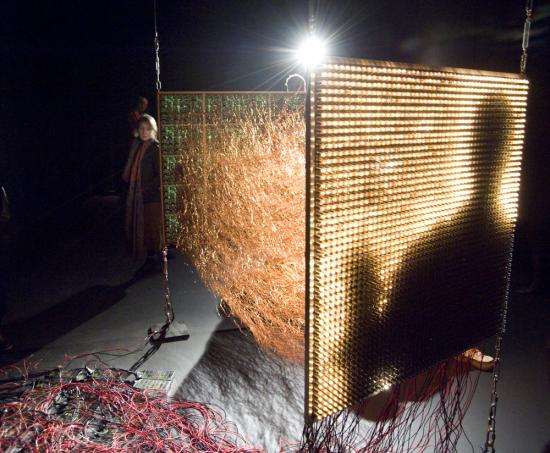
The work Parallel Image by Gebhard Sengmuller, in collaboration with Franz Buchinger, supported by Fels-Multiprint may of inspired the whole concept. An electronic camera obscura and media-archaeological, interactive sculpture. An apparatus for presenting different possible fictions, futures. “Unlike conventional electronic image transmission procedures, “A Parallel Image” is technologically completely transparent, conveying to the viewer a correspondence between real world and transmission that can be sensually experienced.” It presents the fiction that the technology of transmitting moving images was not discovered or invented at all – so no electronic pixels, just a camera and a monitor connected by 2,500 cables in order to track the movement of a body or an object.
Whilst weaving through the dark, curtain bound maze, discovering the separated presentations of Future Obscura, or what we can consider playfully here, as the ‘futurity tunnel’. We come across the video-audio installation data.tron, part of the datamatics project by Ryoji Ikeda. A huge screen (about 15 ft high & 40 foot wide) stands in front of visitors on a flat wall-surface. Various projected sets of data – consisiting of databases, computer consoles and white noise move and unfold before your very eyes. Music plays along with the images issuing forth deep hypnotic sensations. Each single pixel is strictly calculated by a mathematical principle and composed from a combination of pure mathematics. Ikeda reuses and deconstructs the data, building it up into a massive art-work, which also becomes an immersive experience. The same concept was used in his live performance at Transmediale.10 ‘Test Pattern’.
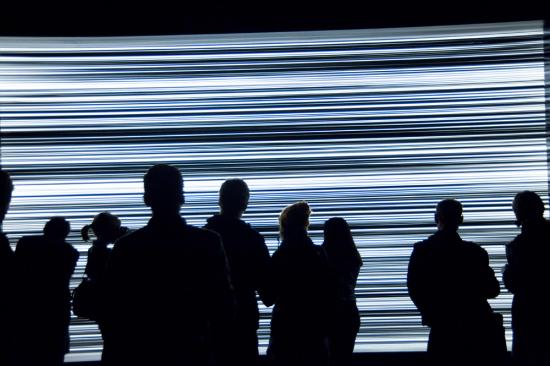
The Artvertiser, a work by Julian Oliver, Damian Stewart, Clara Boj and Diego Diaz, is a tool to swap advertisement with art in public spaces. With a self-made binocular device and dedicated software, you can experience a new metropolitan landscape, replacing the omnipresent adverts which plague our urban environments with art or images of your choice. The swapped, proposed images are often a play on the words of the original advertisement. Whichever image one substituted, the central message of the Artvertiser remains the same; our public city landscapes are bulging with publicity, we want to take that space back and personalize it – quite the same concept of graffiti, but dealing with the reproduction and re-representation of our public spaces. The software running on the device is an open source project and it will soon be available for all to download and use with Smartphones and Standard Camera phones. The Artvertiser points out a thoughtful and critical view point of our present, proposing an alternative future directly linked to our everyday lives. Ironically, this is a theme that is unfortunately scarce or missing in most of the selected Transmediale.10 works.
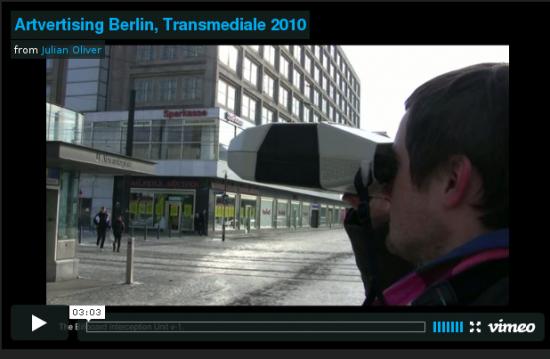
The work Paparazzi Botsby Ken Rinaldo, consisting of a series of autonomous robots. Each of them upright, the height of the average human. Packed with lens-based hardware, such as “cameras, sensors and robotic actuators on a custom-built rolling platform, they move at the speed of a walking human, avoiding walls and obstacles while using infrared sensors to move toward humans.” Capturing images of the visitors as though they were celebrities, flashes go off, then the images are projected up onto the surrounding walls. A popular installation reflecting on the abuse of reproduction and exhibition: some of the images were also uploaded and then distributed through social networking sites – a mass mediatic celebration of the visitors as well as the celebration of the bots.
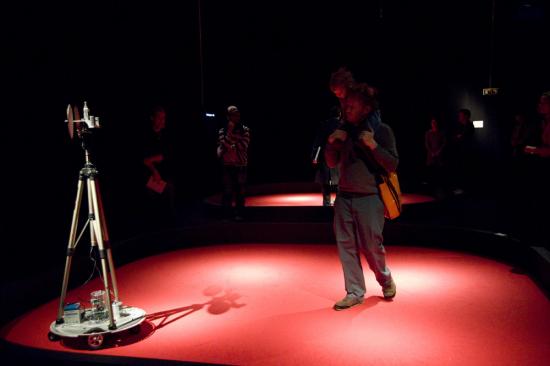
The selection of Transmediale.10 seems to award reproduction of content rather than consciousness of a different form of creativity. Also, the main prize is unexpectedly given to a woman, Michell Teran, with the project Buscando al Sr. Goodbar: a real tour through Murcia, a Spanish town, taking place at the same time on Google Earth and YouTube, an interaction between reality and social media. The work was presented at Transmediale.10 as a video remix of the original work. “The tour audience was introduced to everyday performances and actions happening in the city that often go unnoticed. Somebody solves a Rubik’s Cube in under 2 minutes, a young man plays a piano, a group of friends drunkenly sing together, a 14 year old boy headbangs in his bedroom, somebody is choked, a man teaches himself Arabic and two people fall in love. At certain points the audience left the bus and met some of the video authors who presented them with re-enactments of their performances.”
In the same way the second prize was awarded to the project Bicycle Built For Two Thousand by Aaron Koblin and Daniel Massey. A web-based, software able to record people repeating what they heard, then they used these voices to make a reconstructed version of the song Daisy Bell – the first song that implemented musical speech synthesis in the 1962.
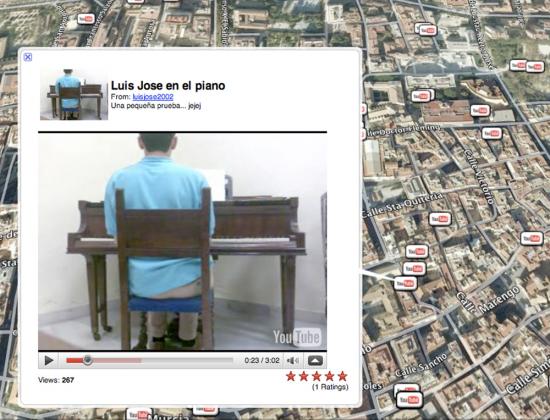
Speaking about the difference between re-production and creation, it is interesting to notice that the group F.A.T were present at the awards. Using intentionally, and excessively open source and pop culture as way of expressing their creative actvities, claiming and distributing activist propoganda-like projects, on networked territories and facilities (facebook/google ndr.) in order to stress out the holes of content present in the Web2.0 culture. For Transmediale.10, they presented a series of projects dedicated to the topic of the week: FUCK GOOGLE. In addition to free software, browser addons, live streams, communiques and on-site workshops, they also built a fake Google Street View car and toured it in the city of Berlin.
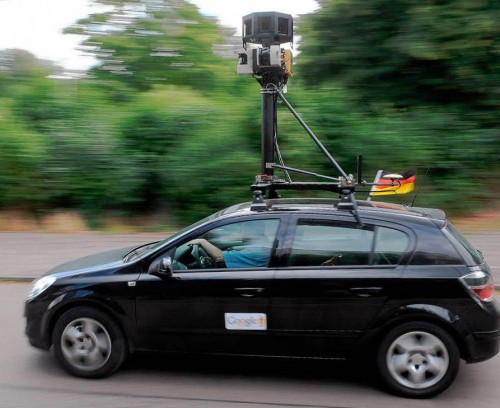
A more singular approach, which revealed different or other connections of a network is shown in Neuropower, by the biologist and artist Warren Neidich who won The Vilem Flusser Theory Award 2010: he researched new ways to manipulate the process of ongoing cerebral reconstruction. Exploring the potential of Neuroaesthetics, formulated in the mid-1990s “as a paradigm capable of describing the complex conditions of the ‘now’-a moment in which global technological networks and novel potentialities for subjectivity are coming into greater focus and correlation to each other. As knowledge becomes ever more commodified, and labor increasingly immaterial, our notions of art, work, and politics…”
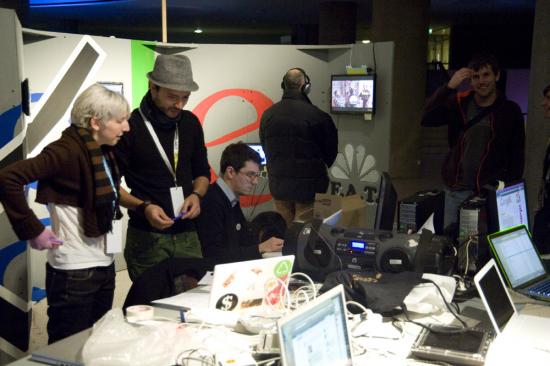
The gap between what could be the future or what we are imagining through the mass-media industry and the challenge that artists and creative thinkers are asked to face, is not really elaborated. A good example is the conference Phuturama: a space dedicated to the possible alternatives of an ‘imaginary’ for the future. One of the guests was Kahaimzon Michel: his description of the new version of Far Cray was mostly focused on the technical improvement of the game and no word at all was spent on the idea, the concept itself: the umpteenth war-games, colonialist and male-centered. The celebration of technology itself was the splitting point of this Festival, as it was somehow already announced at the opening day by Dr. Franke. His main contribution seemded to be about the importance of ‘Avatar’ the movie, for its big technological improvements.
Going back to the events, one of the most awaited speeches was Bruce Sterling’s keynote speech “Atemporality – A cultural speed control” about time and its relation to ‘future’. The main introduction text for Atemporality – A cultural speed control read “The speed of our society is constantly increasing in terms of processes, logistics and media, causing the present to ‘shrink’. We are experiencing the dissolution of meaningful frameworks in a similar way as Henry DeTamble: in politics, the intervals of planning and acting are reduced to the duration of a legislative period and in post-industrial economics volatile unpredictability has come to replace regular traits of growth and stability. Progress as the paradigm of modernity has been replaced by the continuous modulation of events. If progress is to go beyond the banal indulgences that give rise to a never-ending array of car shell designs then we need to analyse our present time with regard to its aesthetics and its media. The structure of the future has changed, and with it our sense of time. Are we running out of a future as a resource for growth, progress and stability? Has our cultural cruise control become defective?”
Reflecting on the proposed theme, Sterling presented Atemporality as he viewed it, an approach in understanding and recontextualizing history, “an effort in humanities” to embrace reality, the now.
“Step one – write problem in a search engine, see if somebody else has solved it already.
Step two – write problem in my blog; study the commentory cross-linked to other guys.
Step three – write my problem in Twitter in a hundred and forty characters. See if I can get it that small. See if it gets retweeted.
Step four – open source the problem; supply some instructables to get me as far as I’ve been able to get, see if the community takes it any further.
Step five – start a Ning social network about my problem, name the network after my problem, see if anybody accumulates around my problem.
Step six – make a video of my problem. Youtube my video, see if it spreads virally, see if any media convergence accumulates around my problem.
Step seven – create a design fiction that pretends that my problem has already been solved. Create some gadget or application or product that has some relevance to my problem and see if anybody builds it.
Step eight – exacerbate or intensify my problem with a work of interventionist tactical media. And step nine – find some kind of pretty illustrations from the Flickr ‘Looking into the Past’ photo pool.” Sterling.
The philosophy of history studies, an objective point of view, a map that does not always reflect the real. Atemporality instead, has to be a “calm pragmatic skepticism about the historical narrative” like telling stories of people who were not the winners, report history that has no literacy or playing fiction into reality, being a “personal public testimony of a future that doesn’t exist”.
“Atemporality is a philosophy of history with a built-in expiration date. It has a built in expiration date. It’s not going to last forever. It’s not a perfect explanation, it’s a contingent explanation for contingent times.
Futurity was expected, futurity is here now, there goes futurity into the past, so long futurity, thank you for an exciting, fulfilling and worthwhile time.” Sterling.
The Atemporal approach asks us to cool things down, challenge the need and desire for a constant, linear future. Proposing not to rush ever onwards, remembering what we have now, reclaiming and rediscovering the qualities we possess rather than feverishly running forward all of the time. You can read Bruce Sterling’s whole speech here – Atemporality for the Creative Artist
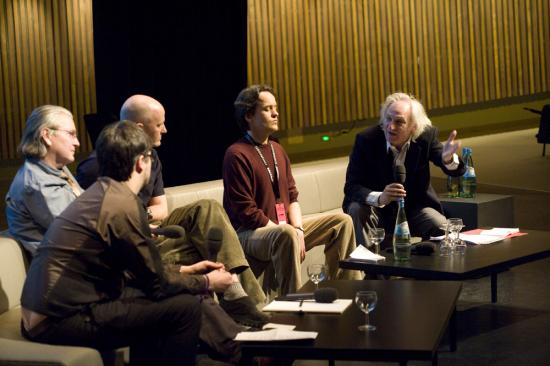
A subject which played a central role for much of the discussions held, was related to the economy and how it addresses the creative work (a third of the speeches were about this topic). The financial crisis had also influenced much of the artistic agenda. Unfortunately all this talking about commerce was often presented without critical reasoning, and so we had a lot of showing off and gesturing about how amazing certain new technologies were. Which gave off a more bland sense of enthusiastism, a technologically determined, already accepted future, without the necessary awareness of the overall social contexts of what it all really means. Yet there were some projects that tried to propose a different view on this theme. The performance Values, by I-Wei Li, pretended to calculate, with the help of a computer, the value (artistic-value) of the participant, based around questions on art and art practice. The Laboratoire Deberlinisation uses an uncommon way to discuss about immigration and value in our globalized world, with the provocative use of an African value, the Afro, an international insurance card and passport.
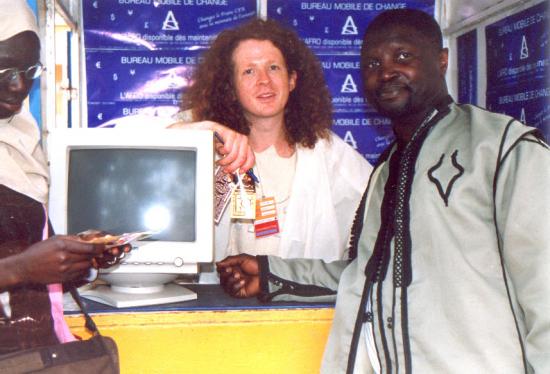
A deep critical, discussion of the current socio-economical situation produced by the international financial crisis, was held in the main auditorium, Liquid democracies. Steve Lambert presented his works and talked about direct politics, re-using our culture and how to subvert it. In his opinion, utopia has to be used as a direction and not as a destination, living moments of freedom: an alternative approach for direct, political change, using small actions and persistence, participating tactically through our cultures. Matteo Pasquinelli later focuses attention on the whole of net society and the digital matrix. He wondered who has the strongest power, who detains the monopolies and which place is dedicated to the workers and specifically to the cognitive (creative) workers? Pasquinelli used the concept of a “new feudalism” to define contemporary societies. The multitude is not fluid but embroils in a participatory process that traps it in-between the oligarchy of the big companies. Democracy in this sense has ended and gives the go-ahead to a post feudalistic society. The end of this construction is an open question: is there any subject able to break the power of these big monopolies?
Parallel to Transmediale festival is Club Transmediale Festival CTM a music and visual arts event held every year in Berlin. The festival started as the musical side of Transmediale and then added more and more interests involving the arts. Through the years it has become more popular and expanded, not just with music during the night, but also with their own exhibitions, talks and lectures during the day. This year the event was even longer than Transmediale itself, starting from January 28th and ending February 7th 2010, with the subject “OVERLAP – Sound & Other Media” giving a lot of attention to the relationship between music and videogames.
A missing element worthy of attention at Transmediale.10 this year, was its audience. Even though the amount of visitors were three times more than last year. The time for questions and discussion with the public was often too short, or ineffective. A contemporary approach in acknowledging the audience would be to understand there is not a clean divide anymore. And even though the old protocols still count in some cases, its representation at the festival was not necessarily a true reflection of the nature of networked, contemporary art and its culture. A hidden and dynamic audience which could have offered their own ‘valid’ interpretations around the subject was lost. Yet, on the whole the festival was extremely interesting in many ways, and had some excellent works and discussions well worth experiencing.
Featured image: make art is an international festival focusing on Free/Libre/Open Source Software (FLOSS), and open content in digital arts
make art, one of the world’s most important free and libre art events, happens far away from the European metropolis, in the small town of Poitiers. However, it does not represent an integral piece of the ville‘s agenda to favour cultural tourism and development, as we might suppose thinking of some Brazilian film festivals and even of Bilbao’s Guggenheim. If something is to blame, it should be the grassroots effort of the native GOTO10 collective.
The name might sound familiar because not long ago they were doing a series of workshops in the UK to introduce FLOSS tools using their own pure:dyne operational system – a GNU/Linux distribution for multimedia creation. Having received some funding from the Arts Council, pure:dyne recently grew in efficiency and popularity.
Personally, the first time I heard about GOTO10 was in 2006, at that year’s Piksel festival. Some of the group’s members were there for audiovisual performances. Yes, they are artists as well – in fact, on the same days of make art, the group was taking part in the Craftivism exhibition, in Bristol. And between producing events, engineering software and, well, making art, they also found time to publish a book.
As diverse as these projects might be, they can all be inferred from the GOTO10’s creative practice, in respect of their real time interaction with people (in workshops) and machines (in live coding, etc). Given the way make art, pure:dyne and the group’s performances are interconnected, we could see them as one and the same activity, extending itself to various platforms.
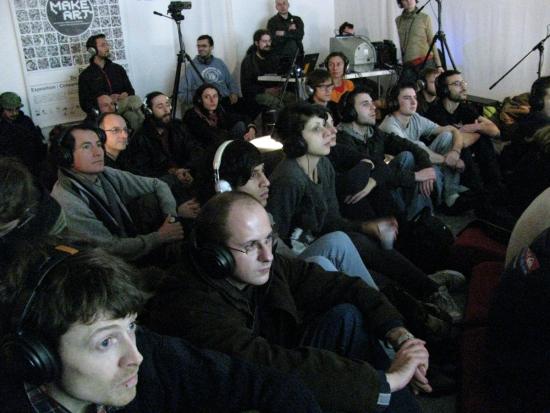
I wouldn’t go as far as to say that, similarly, GOTO10 is a poitou group that has been expanded to other parts of the world. But, now that it has members from Greece, the Netherlands, Taiwan and the UK, the localization of make art seems even more meaningful to the collective’s identity, hinting on where and why it started.
According to Thomas Vriet, one original member who is still in town and mainly responsible for make art production. The group first got together in 2003 to promote digital art performances, workshops and exhibitions in Poitiers – sharing thoughts and ideas on things they were interested in, but could not find in the local art scene or École de Beaux-Arts.
So, in the same way pure:dyne was developed to cope up with GOTO10’s own needs for a live operational system capable of realtime audiovisual processing, make art is the ideal festival they’d wish to attend in town. Both projects find their reason in the group’s artistic demands, and grew simultaneously from it: the inaugural version of the distro was released in 2005, right on time to be used in a workshop in the first make art the following year.
Even though make art’s production is concentrated locally, the event is curated online, by the whole of GOTO10. The other member directly implied in this year’s planning, Marloes de Valk, arrived from Amsterdam just in the first day of the festival. make art is a group initiative that cannot be isolated from the larger open source community – a circuit that includes not only artists and programmers, but other venues as well. It is from this sizeable repository that the pieces that constitute the event’s programme come from. The aforementioned Piksel, for instance, has previously contributed to make art with a special selection of Norwegian works, creating an unexpected interchange between Bergen and Poitiers.
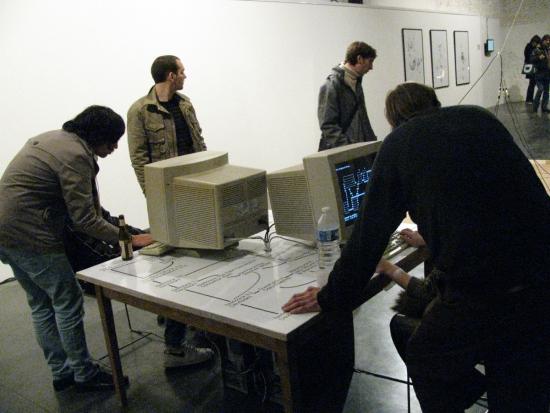
Together with the different Pixelache editions, these festivals form an international calendar of FLOSS art events, closely committed to developments in technology and aesthetics that, in many senses, are far more interesting that the new media proofs-of-concept proliferating elsewhere. But how does such package of extraordinary themes work in the traditional platform of the French countryside?
Altogether, make art seems to be the right size for Poitiers – not too small to feel incomplete, neither too big to feel overwhelming. The night programme may put you off if you are on a budget and decided to stay in the youth hostel (like me): there are no buses to that area after 8pm, forcing you to endure a half hour walk through cold streets. Apart from that, the city space is very well occupied by the festival, with the exhibition and debates in the central Maison de l’Architecture and a couple performances in other venues, emphasizing the curatorial logic. Posters are everywhere in town, competing for attention with those from the film festival.
However, the participation of the poitou community seems very restricted. So far, no local project has ever been sent in response to make art’s call. It might be that the theme is still alien to most people. Not surprisingly, the activity that attracted the majority of local public was the debate “Internet, Freedom and Creation” – which, beyond dealing with themes of more general concern (digital freedoms and copyright), was in French.
One of the efforts to increase this involvement was to open free places in the Fork a House! workshop to local students. Student volunteers could also be found mediating the exhibition and assisting production.
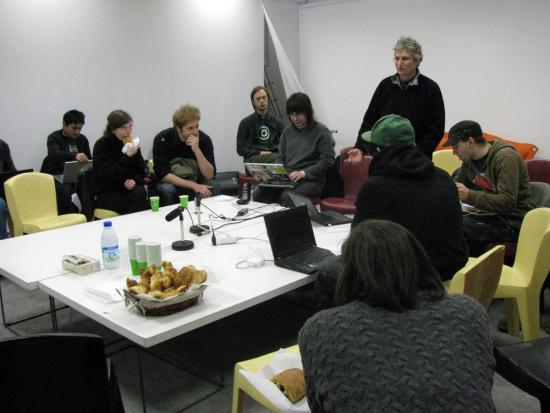
In that sense, the project that seemed to make the most of the festival’s situation was the frugal Breakfast Club. The first of these morning talks hosted by Nathalie Magnan was especially refreshing after the highly technical presentations the day before. Complex subjects were re-discussed over croissants, bringing the tone and rhythm of the event closer to the atmosphere of the #makeart IRC channel (which sometimes was livelier than the physical space).
The priority of Breakfast Club was not transparent accessibility but dialogue. Less of a tutorial and more like the public forum an open-source project cannot really do without. It made things more understandable to a laymen’s audience; it made the whole festival experience more coherent, pointing to directions in which it should grow within the city’s everyday life and structure – without having to be included in Poitiers’ tourism department masterplans.
DIWO At the Dark Mountain: A Mail-Art project across physical and digital networks in collaboration with the Dark Mountain Project; to question the stories that underpin our failing civilisation and to craft new ones for the age ahead.
Join us for the DIWO co-curation event 12-3pm at HTTP Gallery Friday 27 November 2010 and Online here http://www.livestream.com/furtherfield. Log on at noon for a 12.15 start.
Join us to view the work and discuss the concepts and approaches explored and make decisions about how the work can best be displayed in the gallery.
From the webpage you will be able see and hear what we’re doing in the gallery and contribute to the discussion via instant messaging.
If you experience any problems, email aleATfurtherfieldDOTorg.